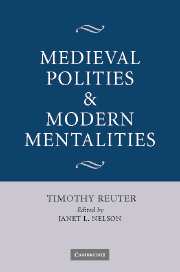Book contents
- Frontmatter
- Contents
- Editor's note
- Acknowledgements
- List of abbreviations
- Editor's introduction
- PART I MODERN MENTALITIES: HISTORIOGRAPHIES, METHODOLOGIES, PRECONCEPTIONS
- PART II THE SYMBOLIC LANGUAGE OF MEDIEVAL POLITICAL ACTION
- PART III POLITICAL STRUCTURES AND INTENTIONS
- 11 Assembly politics in western Europe from the eighth century to the twelfth
- 12 Sex, lies and oath-helpers: the trial of Queen Uota
- 13 Plunder and tribute in the Carolingian empire
- 14 The end of Carolingian military expansion
- 15 The Ottonians and Carolingian tradition
- 16 The making of England and Germany, 850–1050: points of comparison and difference
- 17 King, nobles, others: ‘base’ and ‘superstructure’ in the Ottonian period
- 18 The ‘imperial church system’ of the Ottonian and Salian rulers: a reconsideration
- 19 Peace-breaking, feud, rebellion, resistance: violence and peace in the politics of the Salian era
- 20 The medieval German Sonderweg? The empire and its rulers in the high Middle Ages
- 21 Mandate, privilege, court judgement: techniques of rulership in the age of Frederick Barbarossa
- 22 All quiet except on the Western Front? The emergence of pre-modern forms of statehood in the central Middle Ages
- Index
19 - Peace-breaking, feud, rebellion, resistance: violence and peace in the politics of the Salian era
Published online by Cambridge University Press: 12 August 2009
- Frontmatter
- Contents
- Editor's note
- Acknowledgements
- List of abbreviations
- Editor's introduction
- PART I MODERN MENTALITIES: HISTORIOGRAPHIES, METHODOLOGIES, PRECONCEPTIONS
- PART II THE SYMBOLIC LANGUAGE OF MEDIEVAL POLITICAL ACTION
- PART III POLITICAL STRUCTURES AND INTENTIONS
- 11 Assembly politics in western Europe from the eighth century to the twelfth
- 12 Sex, lies and oath-helpers: the trial of Queen Uota
- 13 Plunder and tribute in the Carolingian empire
- 14 The end of Carolingian military expansion
- 15 The Ottonians and Carolingian tradition
- 16 The making of England and Germany, 850–1050: points of comparison and difference
- 17 King, nobles, others: ‘base’ and ‘superstructure’ in the Ottonian period
- 18 The ‘imperial church system’ of the Ottonian and Salian rulers: a reconsideration
- 19 Peace-breaking, feud, rebellion, resistance: violence and peace in the politics of the Salian era
- 20 The medieval German Sonderweg? The empire and its rulers in the high Middle Ages
- 21 Mandate, privilege, court judgement: techniques of rulership in the age of Frederick Barbarossa
- 22 All quiet except on the Western Front? The emergence of pre-modern forms of statehood in the central Middle Ages
- Index
Summary
From the history of the eleventh and early twelfth centuries, three acts of violence stand out because they found a particularly resonant echo in contemporary historians. The first was the murder of Count Wichmann in 1016 on his way home from a convivium with his rivals Count Balderich and his wife Adela. The act itself was perpetrated by a servus who had evidently been put up to it by the couple. The detailed coverage of the murder in the narrative sources is explicable not least in terms of the interests and family records and traditions of several contemporary bishops of Saxony and Lower Lotharingia whom it directly affected. The second episode was the destruction by Saxon rebels in 1074 of the castle-chapel on the Harzburg and the Salian tombs including those of the brother and son of Henry IV. This too aroused a great deal of attention, both because of the horrific nature of the deed, and because it marked a turning-point in the war between Henry and the rebel Saxons. The third event was the killing of Count Sigehard of Burghausen by his own ministerials at Regensburg in 1104. Responsibility for the murder was laid at the door of Henry IV, and the defection from him of a number of south German magnates as a result signalled the beginning of the end for his regime.
- Type
- Chapter
- Information
- Medieval Polities and Modern Mentalities , pp. 355 - 387Publisher: Cambridge University PressPrint publication year: 2006
- 3
- Cited by



